Controllable Fabrication and Oil–Water Separation Properties of Polyethylene Terephthaloyl-Ethylenediamine-IPN-poly(N-Isopropylacrylamide) Microcapsules
Abstract
1. Introduction
2. Materials and Methods
2.1. Materials
2.2. Preparation and Characterization of O/W Emulsion
2.2.1. Preparation of O/W Emulsion
2.2.2. Measurement of O/W Emulsion Radius
2.2.3. Calculation of the Monodispersity of the O/W Emulsion
2.2.4. Repetitive Experiment
2.3. Preparation of the Microcapsules and the Final Samples
2.3.1. Preparation of P(TPC-EDA) Microcapsules
2.3.2. Preparation of P(TPC-EDA)-IPN-PNIPAM Microcapsules
2.4. Characterization of the Samples
2.4.1. Microscopic and SEM Characterization of the Samples
2.4.2. XPS Tests of the Microcapsules before and after Adding PNIPAM
2.4.3. FTIR Tests of the Microcapsules before and after Adding PNIPAM
2.4.4. The Swelling Recovery Experiment
2.4.5. Absorbing Kerosene Experiment
2.4.6. Calculating the Internal Volume
3. Results
3.1. Characterization Results of O/W Emulsion
3.1.1. Relationship between O/W Emulsion Radius and the Flow Rate
3.1.2. Monodispersity of O/W Emulsion
3.2. Characterization of the Samples
3.2.1. Micrographs and SEM Images of the Samples
3.2.2. XPS Characterization of Samples
3.2.3. FTIR Results of Samples
3.2.4. The Swelling Recovery Ratio of the Samples
3.2.5. The Absorbing Kerosene Ability of the Samples
4. Conclusions
Author Contributions
Funding
Institutional Review Board Statement
Informed Consent Statement
Data Availability Statement
Conflicts of Interest
References
- Tavernier, I.; Wijaya, W.; Van der Meeren, P.; Dewettinck, K.; Patel, A. Food-grade particles for emulsion stabilization. Trends Food Sci. Technol. 2016, 50, 159–174. [Google Scholar] [CrossRef]
- Kiokias, S.; Varzakas, T. Innovative applications of food-related emulsions. Crit. Rev. Food Sci. Nutr. 2017, 57, 3165–3172. [Google Scholar] [CrossRef]
- Mao, L.; Roos, Y.; Biliaderis, C.; Miao, S. Food emulsions as delivery systems for flavor compounds: A review. Crit. Rev. Food Sci. Nutr. 2017, 57, 3173–3187. [Google Scholar] [CrossRef]
- Reufer, M.; Machado, A.; Niederquell, A.; Bohnenblust, K.; Muller, B.; Volker, A.; Kuentz, M. Introducing diffusing wave spectroscopy as a process analytical tool for pharmaceutical emulsion manufacturing. J. Pharm. Sci. 2014, 103, 3902–3913. [Google Scholar] [CrossRef] [PubMed]
- Kiss, N.; Brenn, G.; Pucher, H.; Wieser, J.; Scheler, S.; Jennewein, H.; Suzzi, D.; Khinast, J. Formation of O/W emulsions by static mixers for pharmaceutical applications. Chem. Eng. Sci. 2011, 66, 5084–5094. [Google Scholar] [CrossRef]
- Albert, C.; Beladjine, M.; Tsapis, N.; Fattal, E.; Agnely, F.; Huang, N. Pickering emulsions: Preparation processes, key parameters governing their properties and potential for pharmaceutical applications. J. Control. Release 2019, 309, 302–332. [Google Scholar] [CrossRef]
- Park, H.; Kim, J.; Kim, S.; Ha, E.; Kim, M.; Hwang, S. Pharmaceutical applications of supercritical fluid extraction of emulsions for micro-/nanoparticle formation. Pharmaceutics 2021, 13, 1928. [Google Scholar] [CrossRef]
- Gkotsis, G.; Rickard, J.; Brooker, A.; Bakalis, S.; Grover, L.; Oppenheimer, P.G. Fabrication of optimized skin biomimics for improved interfacial retention of cosmetic emulsions. J. R. Soc. Interface 2018, 15, 1–11. [Google Scholar] [CrossRef]
- Glavac, N.K.; Lunder, M. Preservative efficacy of selected antimicrobials of natural origin in a cosmetic emulsion. Int. J. Cosmet. Sci. 2018, 40, 276–284. [Google Scholar] [CrossRef]
- Venkataramani, D.; Tsulaia, A.; Amin, S. Fundamentals and applications of particle stabilized emulsions in cosmetic formulations. Adv. Colloid Interface Sci. 2020, 283, 102234. [Google Scholar] [CrossRef]
- Bal, A.; Güçlü, G.; İyim, T.; Özgümüş, S. Effects of nanoparticles on film properties of waterborne acrylic emulsions. Polym. Plast. Technol. Eng. 2011, 50, 990–995. [Google Scholar] [CrossRef]
- Naikwadi, A.; Samui, A.; Mahanwar, P. Experimental investigation of nano/microencapsulated phase change material emulsion based building wall paint for solar thermal energy storage. J. Polym. Res. 2021, 28, 438. [Google Scholar] [CrossRef]
- Yin, D.; Ma, L.; Liu, J.; Zhang, Q. Pickering emulsion: A novel template for microencapsulated phase change materials with polymer–silica hybrid shell. Energy 2014, 64, 575–581. [Google Scholar] [CrossRef]
- Silverstein, M. Emulsion-templated polymers: Contemporary contemplations. Polymer 2017, 126, 261–282. [Google Scholar]
- Chu, L.-Y.; Yamaguchi, T.; Nakao, S. A molecular-recognition microcapsule for environmental stimuli-responsive controlled release. Adv. Mater. 2002, 14, 386–389. [Google Scholar] [CrossRef]
- Bollhorst, T.; Rezwan, K.; Maas, M. Colloidal capsules: Nano- and microcapsules with colloidal particle shells. Chem. Soc. Rev. 2017, 46, 2091–2126. [Google Scholar]
- Wang, J.-Y.; Yu, H.-R.; Xie, R.; Ju, X.-J.; Yu, Y.-L.; Chu, L.-Y.; Zhang, Z. Alginate/protamine/silica hybrid capsules with ultrathin membranes for laccase immobilization. AIChE J. 2013, 59, 380–389. [Google Scholar] [CrossRef]
- Niculescu, A.-G.; Chircov, C.; Bîrcă, A.; Grumezescu, A. Nanomaterials synthesis through microfluidic methods: An updated overview. Nanomaterials 2021, 11, 864. [Google Scholar] [CrossRef]
- Morimoto, Y.; Kiyosawa, M.; Takeuchi, S. Three-dimensional printed microfluidic modules for design changeable coaxial microfluidic devices. Sens. Actuators B Chem. 2018, 274, 491–500. [Google Scholar] [CrossRef]
- Zeng, S.; Liu, X.; Xie, H.; Lin, B. Basic technologies for droplet microfluidics. Top. Curr. Chem. 2011, 304, 69–90. [Google Scholar]
- Baah, D.; Tigner, J.; Bean, K.; Britton, B.; Walker, N.; Henderson, G.; Floyd-Smith, T. Preparation of planar graded refractive index nanocomposites using microfluidics. Mater. Sci. Eng. B 2011, 176, 883–888. [Google Scholar] [CrossRef]
- Ma, J.; Wang, Y.; Liu, J. Biomaterials meet microfluidics: From synthesis technologies to biological applications. Micromachines 2017, 8, 255. [Google Scholar] [CrossRef] [PubMed]
- Wen, N.; Zhao, Z.; Fan, B.; Chen, D.; Men, D.; Wang, J.; Chen, J. Development of droplet microfluidics enabling high-throughput single-cell analysis. Molecules 2016, 21, 881. [Google Scholar] [CrossRef] [PubMed]
- Zhou, W.; Yan, Y.; Guo, Q.; Ji, H.; Wang, H.; Xu, T.; Makabel, B.; Pilarsky, C.; He, G.; Yu, X.; et al. Microfluidics applications for high-throughput single cell sequencing. J. Nanobiotechnol. 2021, 19, 312. [Google Scholar] [CrossRef]
- Guzzi, F.; Candeloro, P.; Coluccio, M.; Cristiani, C.; Parrotta, E.; Scaramuzzino, L.; Scalise, S.; Dattola, E.; D’Attimo, M.; Cuda, G.; et al. A disposable passive microfluidic device for cell culturing. Biosensors 2020, 10, 18. [Google Scholar] [CrossRef]
- Sun, T.; Wang, G.; Feng, L.; Liu, B.; Ma, Y.; Jiang, L.; Zhu, D. Reversible switching between superhydrophilicity and superhydrophobicity. Angew. Chem. Int. Ed. 2004, 43, 357–360. [Google Scholar] [CrossRef]
- Zou, L.-B.; Gong, J.-Y.; Ju, X.-J.; Liu, Z.; Wang, W.; Xie, R.; Chu, L.-Y. Smart membranes for biomedical applications. Chin. J. Chem. Eng. 2022, 49, 34–45. [Google Scholar] [CrossRef]
- Strachota, B.; Oleksyuk, K.; Strachota, A.; Šlouf, M. Porous hybrid poly(N-isopropylacrylamide) hydrogels with very fast volume response to temperature and pH. Eur. Polym. J. 2019, 120, 109213. [Google Scholar] [CrossRef]
- Patra, D.; Ozdemir, F.; Miranda, O.; Samanta, B.; Sanyal, A.; Rotello, V. Formation and size tuning of colloidal microcapsules via host-guest molecular recognition at the liquid-liquid interface. Langmuir 2009, 25, 13852–13854. [Google Scholar] [CrossRef]
- Zhang, H.; Tumarkin, E.; Peerani, R.; Nie, Z.; Sullan, R.; Walker, G.; Kumacheva, E. Microfluidic production of biopolymer microcapsules with controlled morphology. J. Am. Chem. Soc. 2006, 128, 12205–12210. [Google Scholar] [CrossRef]
- Mytara, A.; Chronaki, K.; Nikitakos, V.; Papaspyrides, C.; Beltsios, K.; Vouyiouka, S. Synthesis of polyamide-based microcapsules via interfacial polymerization: Effect of key process parameters. Materials 2021, 14, 5895. [Google Scholar] [CrossRef] [PubMed]
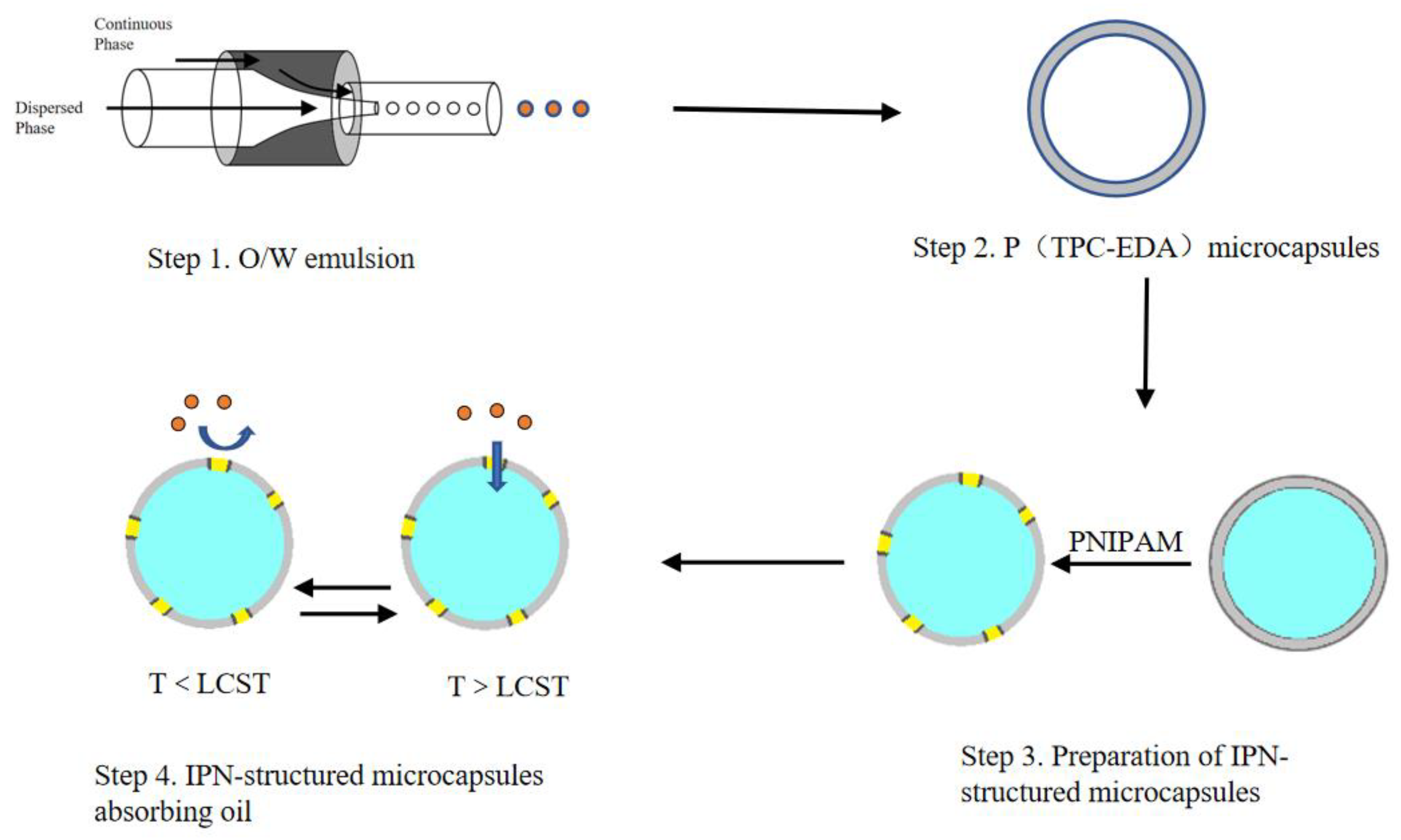
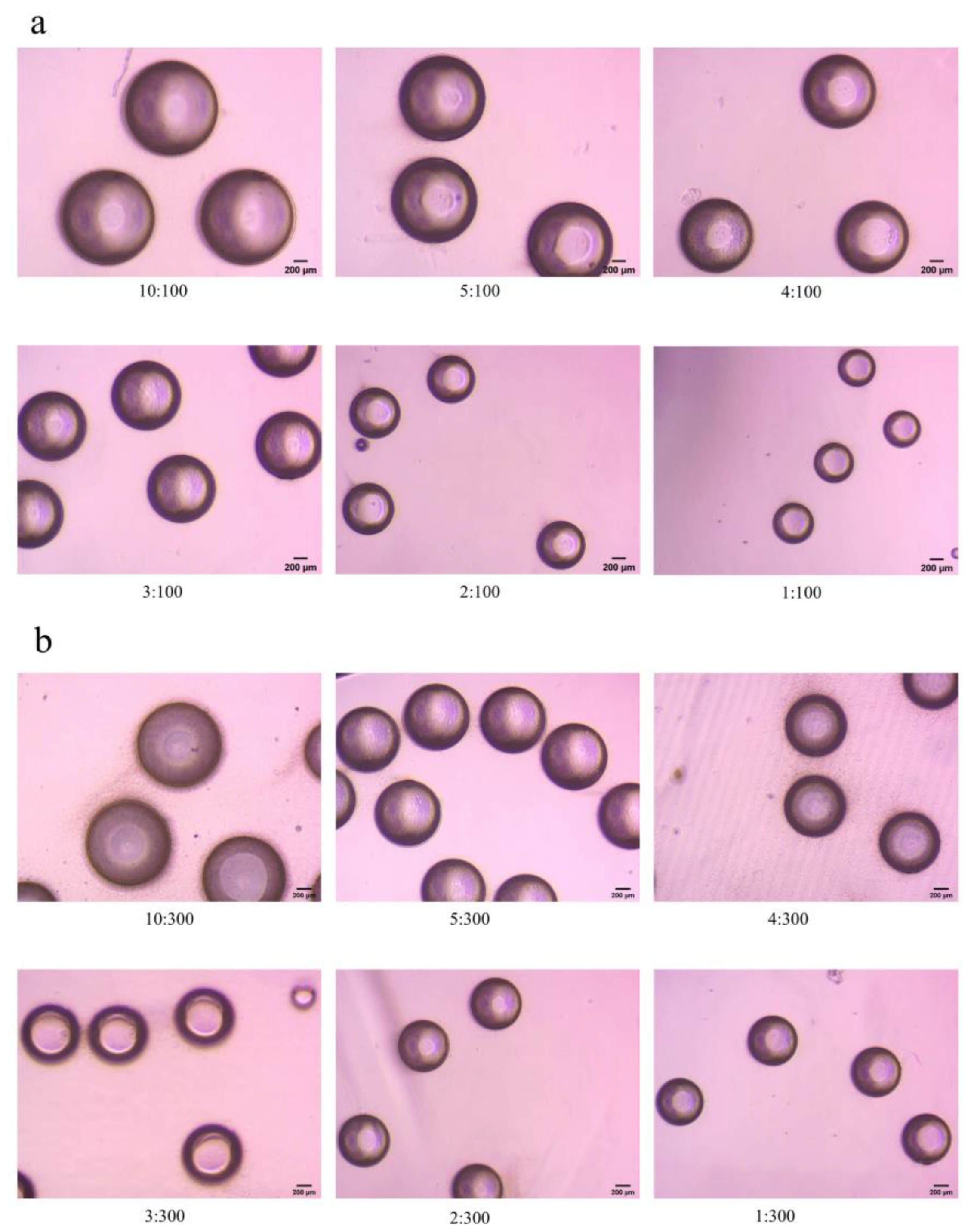
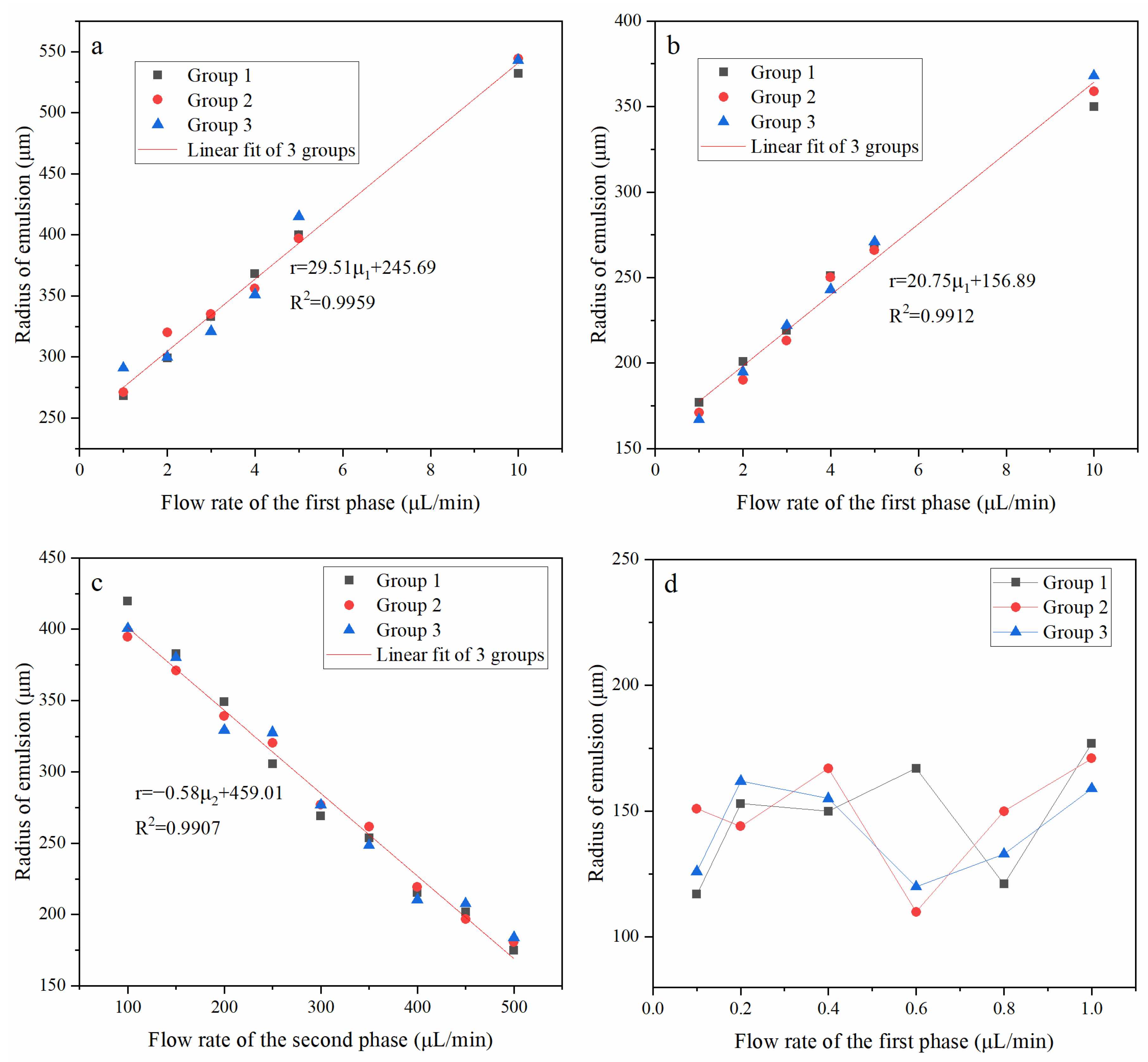
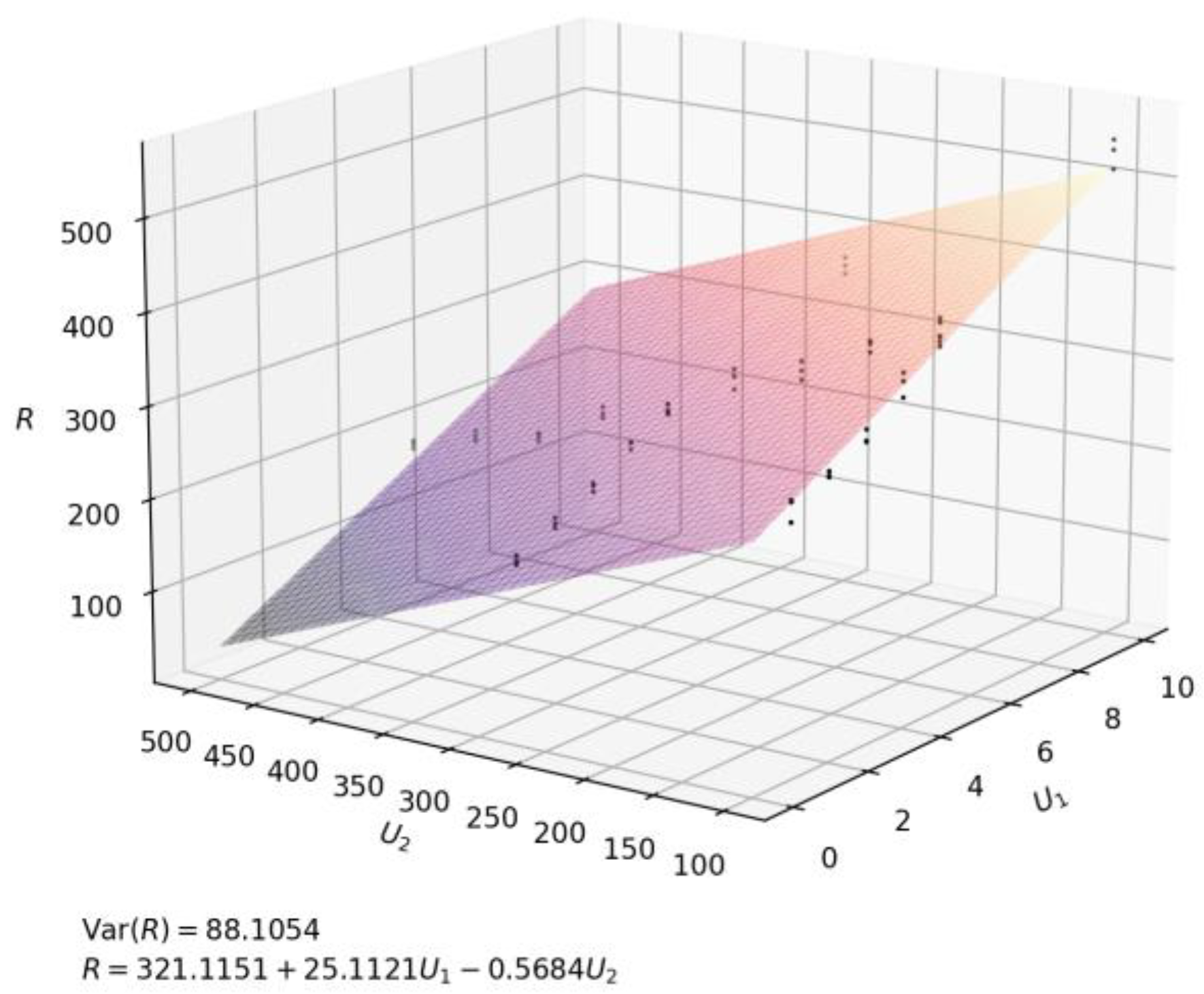
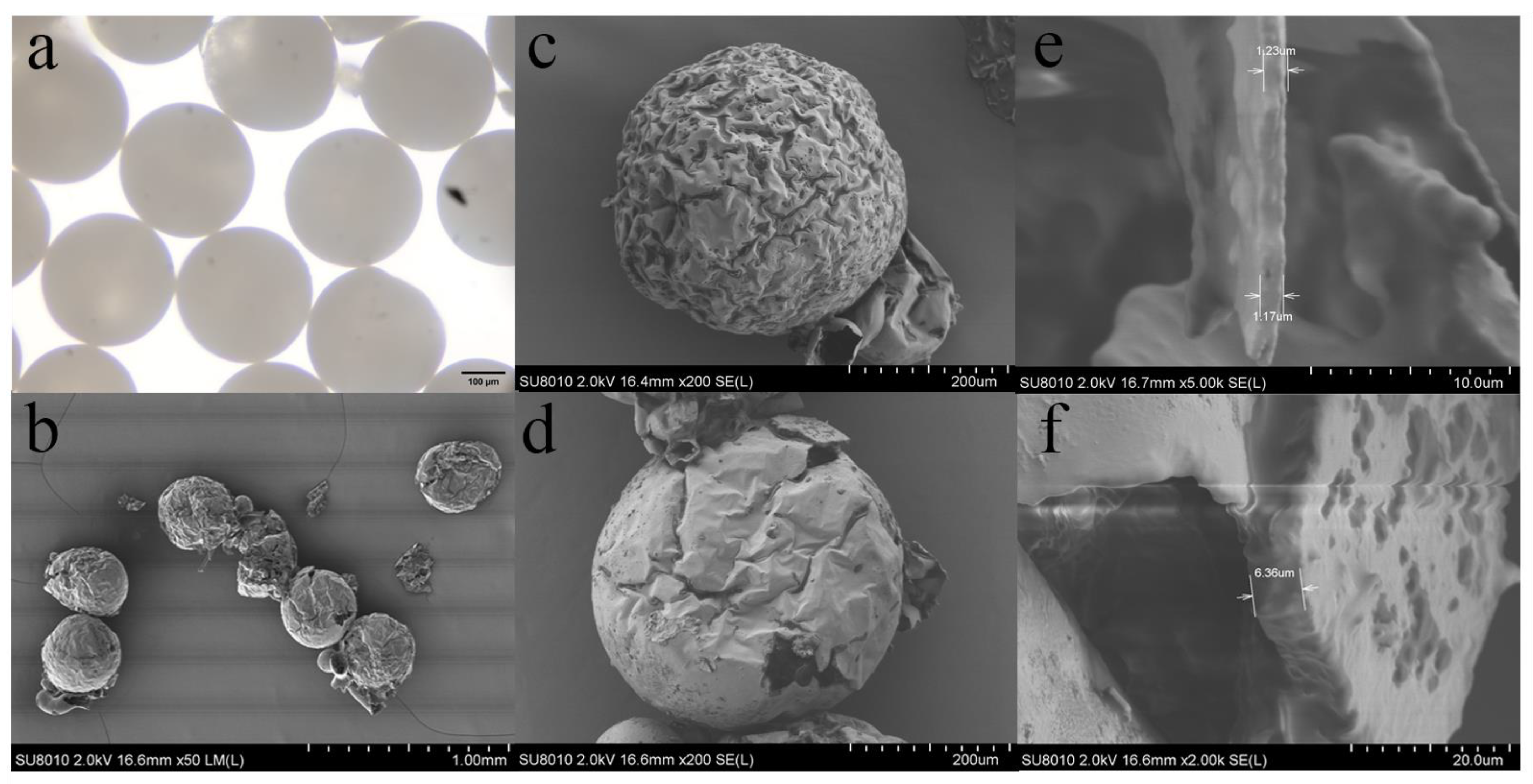

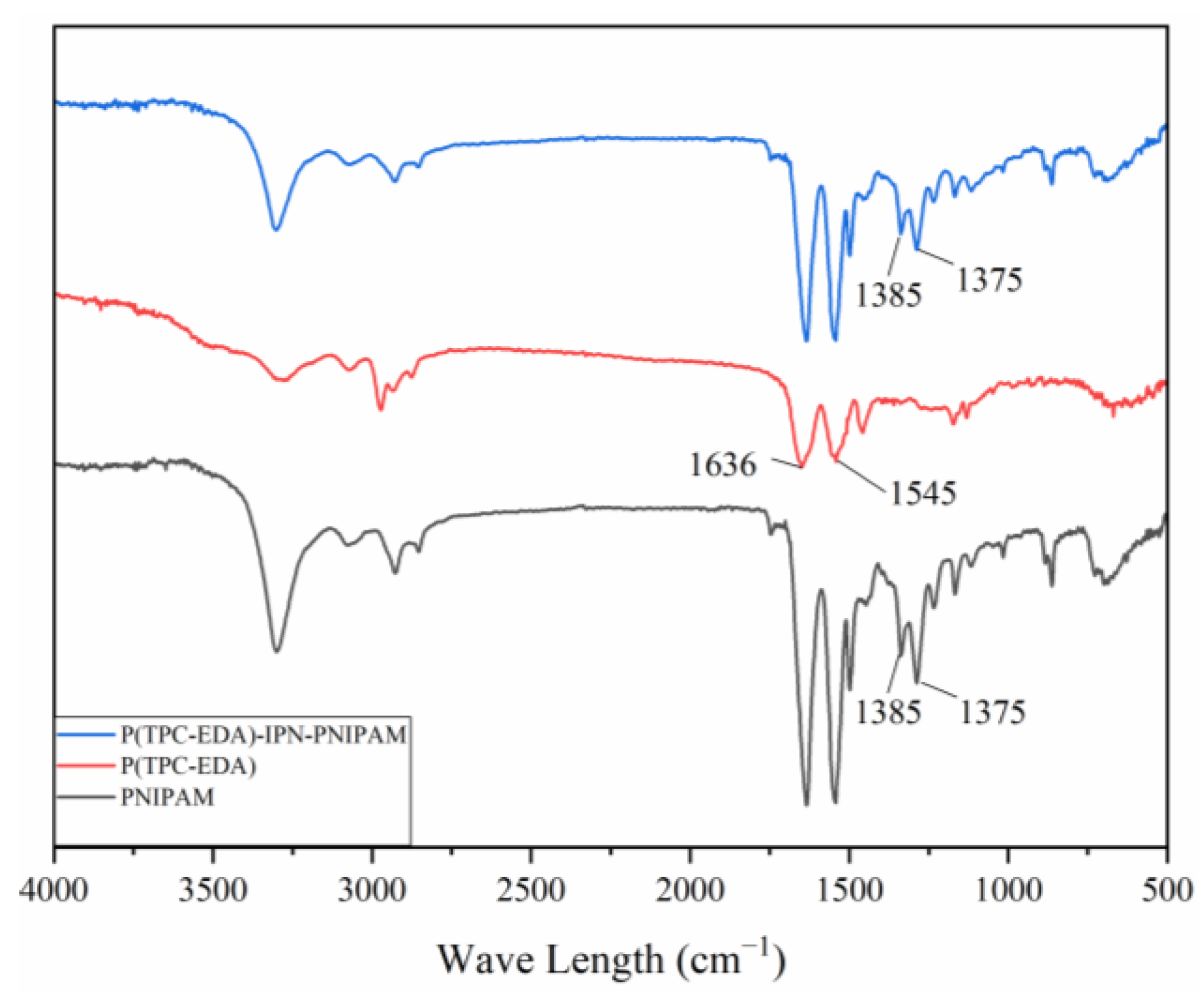

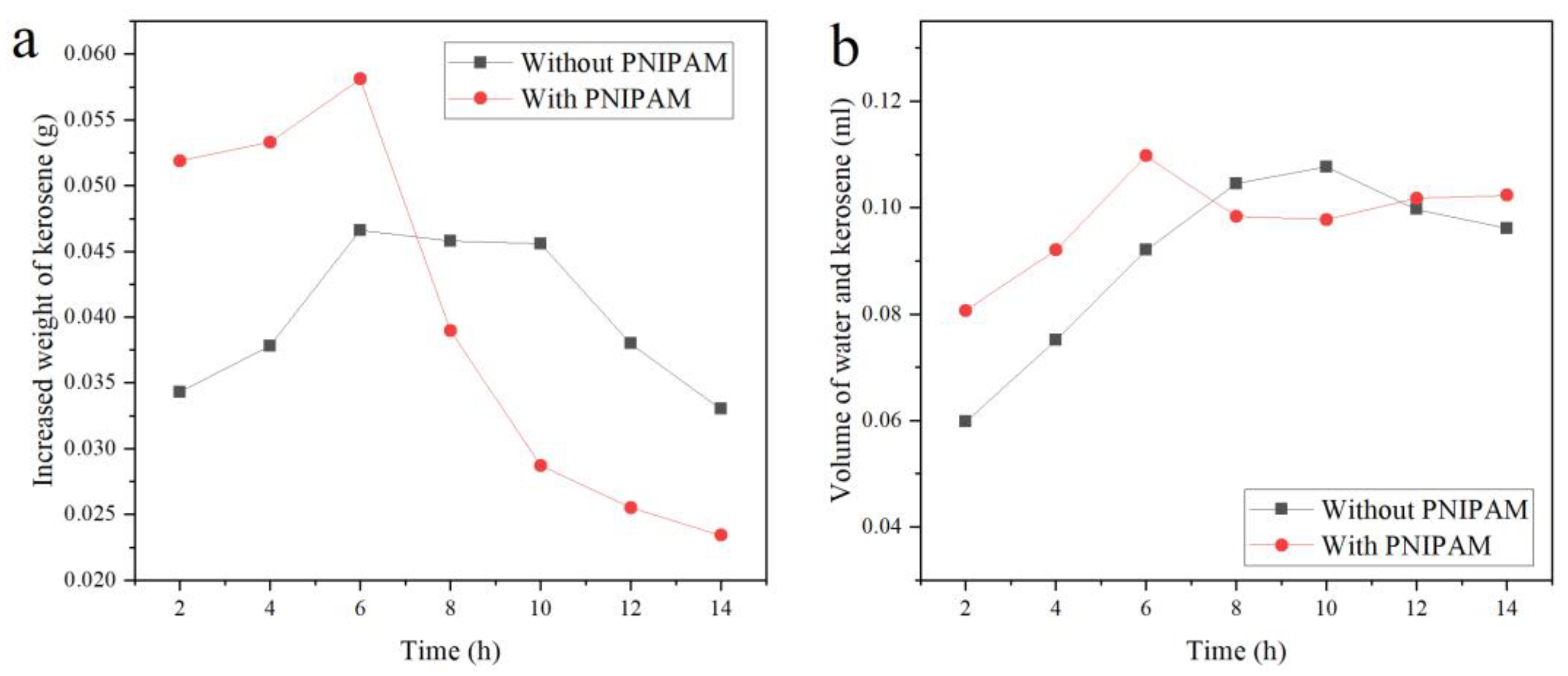
| Concentration of Each Component | ||
|---|---|---|
| Component Name | Without PNIPAM | With PNIPAM |
| TPC | 5%wt | 5%wt |
| EDA | 5%wt | 5%wt |
| NIPAM | 0 | 0.5%wt |
| U1 (μL/min) | U2 (μL/min) | R (μm) | δ |
|---|---|---|---|
| 1 | 300 | 172 | 0.116 |
| 2 | 300 | 195 | 0.114 |
| 3 | 300 | 218 | 0.116 |
| 4 | 300 | 248 | 0.106 |
| 5 | 300 | 268 | 0.116 |
| 10 | 300 | 389 | 0.091 |
| 5 | 100 | 405 | 0.126 |
| 5 | 150 | 378 | 0.124 |
| 5 | 200 | 339 | 0.081 |
| 5 | 250 | 318 | 0.100 |
| 5 | 300 | 274 | 0.096 |
| 5 | 350 | 255 | 0.114 |
| 5 | 400 | 215 | 0.112 |
| 5 | 450 | 202 | 0.133 |
| 5 | 500 | 180 | 0.093 |
| Atomic Name | Content before Adding PNIPAM (%) | Content after Adding PNIPAM (%) |
|---|---|---|
| C1s | 79.72 | 84.83 |
| O1s | 19.62 | 13.92 |
| N1s | 0.66 | 1.7 |
Disclaimer/Publisher’s Note: The statements, opinions and data contained in all publications are solely those of the individual author(s) and contributor(s) and not of MDPI and/or the editor(s). MDPI and/or the editor(s) disclaim responsibility for any injury to people or property resulting from any ideas, methods, instructions or products referred to in the content. |
© 2022 by the authors. Licensee MDPI, Basel, Switzerland. This article is an open access article distributed under the terms and conditions of the Creative Commons Attribution (CC BY) license (https://creativecommons.org/licenses/by/4.0/).
Share and Cite
Liu, M.; Zhao, D.; Lv, H.; Liang, Y.; Yang, Y.; Hong, Z.; Liu, J.; Dai, K.; Xiao, X. Controllable Fabrication and Oil–Water Separation Properties of Polyethylene Terephthaloyl-Ethylenediamine-IPN-poly(N-Isopropylacrylamide) Microcapsules. Polymers 2023, 15, 53. https://doi.org/10.3390/polym15010053
Liu M, Zhao D, Lv H, Liang Y, Yang Y, Hong Z, Liu J, Dai K, Xiao X. Controllable Fabrication and Oil–Water Separation Properties of Polyethylene Terephthaloyl-Ethylenediamine-IPN-poly(N-Isopropylacrylamide) Microcapsules. Polymers. 2023; 15(1):53. https://doi.org/10.3390/polym15010053
Chicago/Turabian StyleLiu, Meng, Dan Zhao, Hui Lv, Yunjing Liang, Yannan Yang, Zongguo Hong, Jingxue Liu, Kang Dai, and Xincai Xiao. 2023. "Controllable Fabrication and Oil–Water Separation Properties of Polyethylene Terephthaloyl-Ethylenediamine-IPN-poly(N-Isopropylacrylamide) Microcapsules" Polymers 15, no. 1: 53. https://doi.org/10.3390/polym15010053
APA StyleLiu, M., Zhao, D., Lv, H., Liang, Y., Yang, Y., Hong, Z., Liu, J., Dai, K., & Xiao, X. (2023). Controllable Fabrication and Oil–Water Separation Properties of Polyethylene Terephthaloyl-Ethylenediamine-IPN-poly(N-Isopropylacrylamide) Microcapsules. Polymers, 15(1), 53. https://doi.org/10.3390/polym15010053






